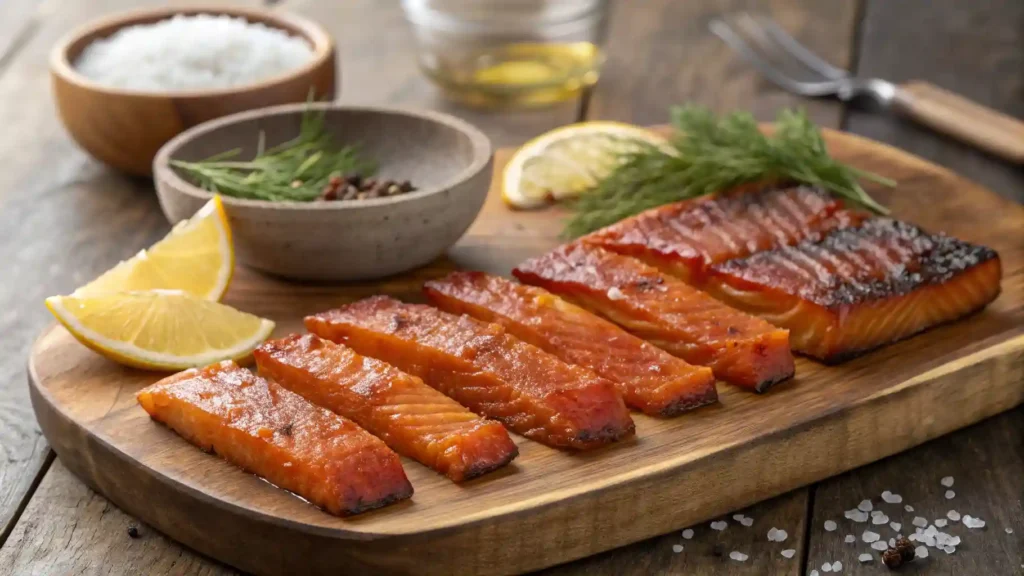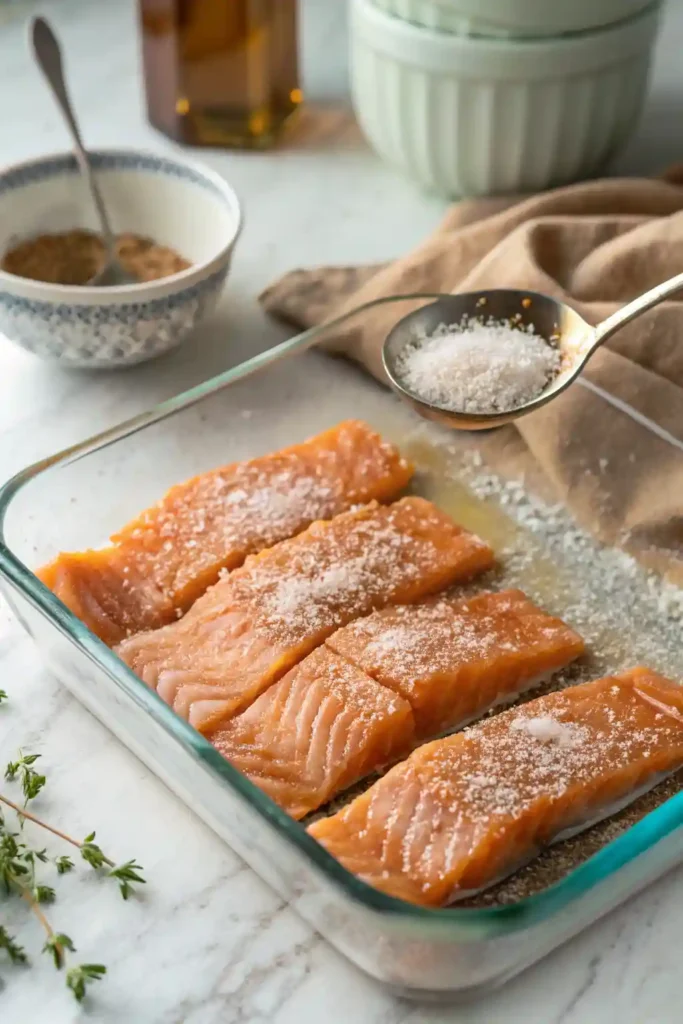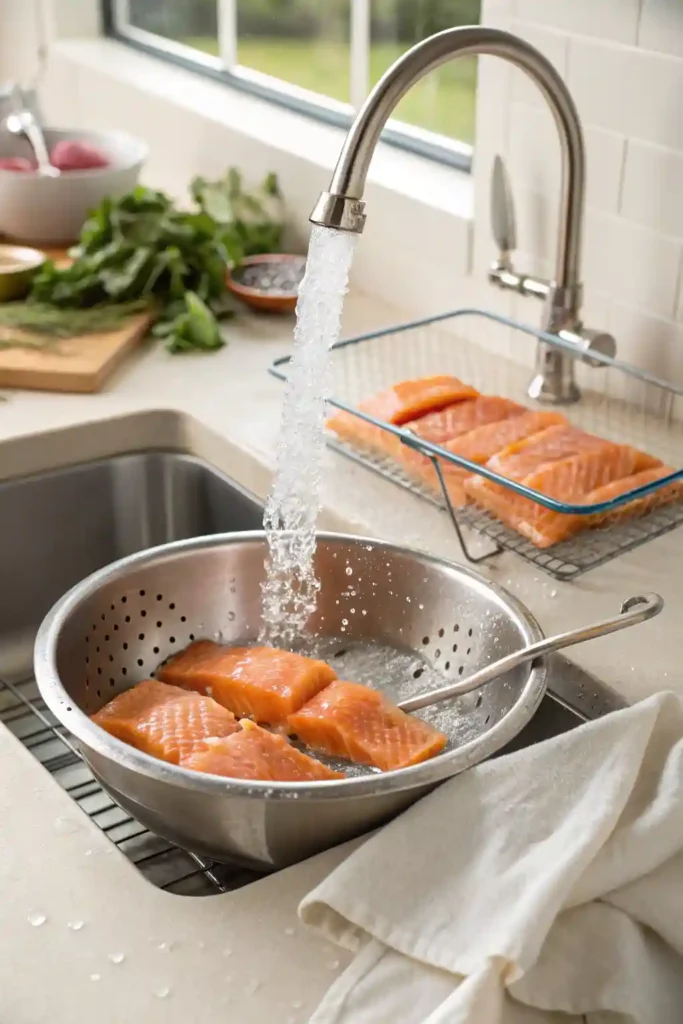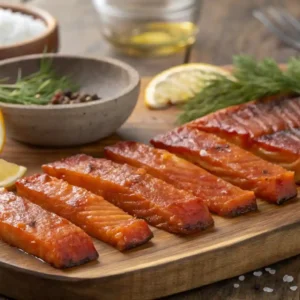Savory-Smoked Salmon Candy merges the best parts of wild Alaskan or Atlantic salmon with a sweet-salty brine. Traditionally, salmon candy features a cure of salt and sugar that locks in moisture and infuses flavor. After curing, you allow the fish to smoke slowly until it reaches a tender, caramelized texture. These thinly sliced pieces often glisten like glossy jerky, hence the “candy” nickname.

This recipe outlines a simple approach to salmon candy, from preparing the brine to smoking the fish. The result is firm, sweet, smoky salmon you can eat as-is, crumble over salads, or pair with crackers and cheese. Let’s discover why you’ll love making it at home.
Table of Contents
Why You’ll Love This Recipe
- Unique Sweet-Salty Profile
Unlike standard smoked salmon that’s purely savory, salmon candy combines sugar, salt, and gentle heat to create a distinctive flavor that’s perfect for snacking. - Fascinating Texture
Each strip of fish emerges from the smoker slightly chewy on the outside, yet remains moist and tender inside. It’s reminiscent of jerky, but still distinctly salmon. - Approachable Method
Although it sounds gourmet, the steps are straightforward: cure in salt and brown sugar, then smoke slowly. You don’t need advanced skills—just time and a bit of patience. - Versatile Uses
Enjoy salmon candy on its own, break it into pieces for salads or pasta, or add it to cheese boards. It also travels well, making it a fun road-trip snack. - Make It Your Way
You can choose a mild or bold smoke, alter the sweetness level, or add extra spices like garlic powder, chili flakes, or maple syrup for a unique twist. - Longer Shelf Life
Because it’s partially cured and smoked, salmon candy can last longer in the fridge than fresh, raw fish. It’s a practical, flavorful way to enjoy salmon over an extended period.
Whether you’ve tried Alaskan sockeye salmon candy on a trip to Alaska or you’re new to the idea, you’ll find this homemade version both fun and rewarding to create.
Ingredients
These components give salmon candy its signature flavor and texture:

- Fresh Salmon Fillet (1–2 lb)
- Use wild Alaskan or Atlantic salmon. Sockeye has a beautiful color and robust taste.
- Skin-on fillets work best; you can remove the skin after smoking if desired.
- Use wild Alaskan or Atlantic salmon. Sockeye has a beautiful color and robust taste.
- Dry Brine (Salt–Sugar Mix)
- ½ cup kosher salt (or sea salt)
- 1 cup brown sugar (light or dark)
- (Optional) 2 tablespoons white sugar if you crave extra sweetness
- (Optional) 1 teaspoon ground black pepper for mild spice
- Smoke Wood Chips
- Hickory, cherry, or apple wood provide a sweet-smoky balance. Some prefer alder for a more traditional fish aroma.
- Hickory, cherry, or apple wood provide a sweet-smoky balance. Some prefer alder for a more traditional fish aroma.
- Optional Flavors
- ¼ cup maple syrup or honey brushed onto the fish for a glossy, candy-like finish.
- A pinch of chili flakes if you enjoy a bit of heat.
- ¼ cup maple syrup or honey brushed onto the fish for a glossy, candy-like finish.
Instructions
Follow these steps to transform your fillet into sweet, smoke-kissed morsels of salmon candy:
Step 1: Prep the Salmon
- Pat Dry: Rinse the salmon under cold water, then pat it thoroughly with paper towels.
- Cut into Strips: Slice the fillet into strips about 1 inch wide and 4–5 inches long. This size ensures uniform curing and a jerky-like feel.
Step 2: Cure with Salt and Sugar

- Create the Dry Brine: In a bowl, mix ½ cup salt and 1 cup brown sugar. Add any extra spices if desired.
- Layer: Spread a thin layer of the cure in a container or baking sheet. Lay salmon strips on top, then cover them completely with the remaining salt-sugar mixture.
- Cover: Wrap the dish with plastic wrap or foil. Place it in the refrigerator to cure overnight (8–12 hours). The cure draws out moisture and sets the candy-like flavor.
Step 3: Rinse and Dry

- Rinse: Remove the salmon from the cure. Rinse each piece under cold water to wash away excess salt and sugar.
- Pat Dry: Gently pat the fish strips with paper towels. Let them air-dry on a rack for 30 minutes. This forms a “pellicle,” a tacky surface that helps smoke adhere.
Step 4: Smoke the Salmon

- Preheat Smoker: Aim for smoker temps of 150–160°F (65–71°C) for a slow, low heat. If your smoker can’t go that low, set it to around 175°F and watch closely.
- Add Wood Chips: Use hickory or apple chips for a sweet, aromatic smoke. Let them start smoking before adding fish.
- Arrange Strips: Lay salmon strips on the smoker grate, leaving space so smoke circulates.
- Slow Smoke: Smoke for about 2–3 hours, depending on how firm or chewy you want the fish. A typical internal temperature to aim for is around 145°F (63°C), but many prefer to go by texture rather than strict temperature.
- (Optional) Glaze: Halfway through, brush maple syrup or honey on the strips to boost the candy-like sheen.
Step 5: Cool and Store
- Rest: Remove strips from the smoker and let them cool on a wire rack.
- Sample: Slice off a small piece to check flavor and dryness—adjust future smoke or brining times if needed.
- Store: Keep salmon candy in an airtight container in the fridge for up to a week. If you want to store it for a longer period, place it in a sealed freezer bag. Thaw in the fridge before enjoying.
Pro Tips and Variations
- Use a Larger Fillet: If you want more yield, pick up a bigger fillet (2–3 lb). Make sure to double the brine accordingly.
- Try an Asian-Style Marinade: Mix soy sauce, ginger, and a bit of sriracha into the cure. This method yields a sweet-spicy glaze reminiscent of korean or teriyaki fish jerky.
- Hot vs. Cold Smoking: Classic salmon candy uses lower smoke temps (like 150–160°F). If your smoker only does higher temperatures, adjust cooking time so the strips don’t dry out too much.
- Experiment with Woods: Hickory, cherry, and apple each add unique aromas. Alder is a classic for alaskan-style fish.
- Sustainably Sourced: If possible, buy from reputable fish suppliers or a local butcher to ensure quality, especially if you want that wild Alaskan flavor.
- Spice Blends: Add garlic powder, onion powder, or a pinch of chili flakes to your brine for extra dimension.
Serving Suggestions
- Party Platter: Pair salmon candy with cream cheese, crackers, grapes, or pickled vegetables on a charcuterie board.
- Breakfast Side: Serve a few strips alongside scrambled eggs or an omelet. The sweet-smoky fish goes great with savory eggs.
- Salads: Slice or flake small bits of candy into green salads, adding a sweet-savory crunch.
- Soups or Stews: Stir some shredded salmon candy into chowders for a smoky punch.
- Sandwich Fillings: Layer them with lettuce, onion, and a dab of spicy mayo for a quick, protein-packed lunch.
- Hiking or Camping Snack: Salmon candy is sturdy enough for short-term travel. Keep it chilled until you leave, then enjoy on the trail.
Conclusion
Savory-Smoked Salmon Candy brings a distinctive twist to smoked fish. By combining a sweet-salty cure with slow cooking and gentle smoke, you transform regular salmon into flavorful, snackable strips reminiscent of jerky. Whether you use wild Alaskan or Atlantic salmon, the result is a synergy of sweet and savory that remains tender yet chewy. The method is straightforward—cure overnight, rinse, then smoke. The reward is well worth the patience.
Once you taste this candy-like fish, you’ll see why it’s a local delicacy in places like Alaska and a rising star at gourmet shops. It’s a treat that pairs well with bagels, salads, or just eaten plain. Plus, you control salt, sugar, and add-ons, making it a more personalized recipe than any store-bought product. If you love smoked salmon or you’re seeking a new way to enjoy fish, give this approach a try. The sweet, smoky satisfaction might just make it your next favorite snack.

Salmon Candy
Ingredients
Fresh Salmon Fillet (1–2 lb)
- Use wild Alaskan or Atlantic salmon. Sockeye has a beautiful color and robust taste.
- Skin-on fillets work best; you can remove the skin after smoking if desired.
Dry Brine (Salt–Sugar Mix)
- ½ cup kosher salt or sea salt
- 1 cup brown sugar light or dark
- Optional 2 tablespoons white sugar if you crave extra sweetness
- Optional 1 teaspoon ground black pepper for mild spice
Smoke Wood Chips
- Hickory cherry, or apple wood provide a sweet-smoky balance. Some prefer alder for a more traditional fish aroma.
Optional Flavors
- ¼ cup maple syrup or honey brushed onto the fish for a glossy candy-like finish.
- A pinch of chili flakes if you enjoy a bit of heat.
Instructions
Step 1: Prep the Salmon
- Pat Dry: Rinse the salmon under cold water, then pat it thoroughly with paper towels.
- Cut into Strips: Slice the fillet into strips about 1 inch wide and 4–5 inches long. This size ensures uniform curing and a jerky-like feel.
Step 2: Cure with Salt and Sugar
- Create the Dry Brine: In a bowl, mix ½ cup salt and 1 cup brown sugar. Add any extra spices if desired.
- Layer: Spread a thin layer of the cure in a container or baking sheet. Lay salmon strips on top, then cover them completely with the remaining salt-sugar mixture.
- Cover: Wrap the dish with plastic wrap or foil. Place it in the refrigerator to cure overnight (8–12 hours). The cure draws out moisture and sets the candy-like flavor.
Step 3: Rinse and Dry
- Rinse: Remove the salmon from the cure. Rinse each piece under cold water to wash away excess salt and sugar.
- Pat Dry: Gently pat the fish strips with paper towels. Let them air-dry on a rack for 30 minutes. This forms a “pellicle,” a tacky surface that helps smoke adhere.
Step 4: Smoke the Salmon
- Preheat Smoker: Aim for smoker temps of 150–160°F (65–71°C) for a slow, low heat. If your smoker can’t go that low, set it to around 175°F and watch closely.
- Add Wood Chips: Use hickory or apple chips for a sweet, aromatic smoke. Let them start smoking before adding fish.
- Arrange Strips: Lay salmon strips on the smoker grate, leaving space so smoke circulates.
- Slow Smoke: Smoke for about 2–3 hours, depending on how firm or chewy you want the fish. A typical internal temperature to aim for is around 145°F (63°C), but many prefer to go by texture rather than strict temperature.
- (Optional) Glaze: Halfway through, brush maple syrup or honey on the strips to boost the candy-like sheen.
Step 5: Cool and Store
- Rest: Remove strips from the smoker and let them cool on a wire rack.
- Sample: Slice off a small piece to check flavor and dryness—adjust future smoke or brining times if needed.
- Store: Keep salmon candy in an airtight container in the fridge for up to a week. If you want to store it for a longer period, place it in a sealed freezer bag. Thaw in the fridge before enjoying.
Notes
Nutrition Information (Per Serving):
Calories: 180 kcal Total Fat: 8g Saturated Fat: 2g Protein: 18g Carbohydrates: 6g Sugars: 5g Fiber: 0g Sodium: 480mg Cholesterol: 45mgFAQs
What does salmon candy taste like?
Salmon candy is sweet and smoky, with a chewy texture similar to jerky but more tender. The sugary brine caramelizes around the fish, creating a lightly sticky exterior.
Is salmon candy good for you?
In moderation, yes. It’s still fish, high in protein and healthy fats. However, it does contain extra salt and sugar from the cure, so enjoy it as an occasional treat.
Why is salmon so tasty?
Salmon has a rich, fatty composition that holds onto flavor well. Its natural oils create a moist, savory bite, especially when combined with a smoky or sweet profile.
Why is salmon meat so pink?
Salmon’s pink hue comes from naturally occurring pigments in its diet (like krill). Wild-caught salmon often has a deeper color, while farmed fish may vary based on feed.
What to serve with salmon candy?
Salmon candy pairs well with crackers, cream cheese, or tangy sides like pickles and coleslaw. It also makes a great topping for salads or a quick protein snack.


